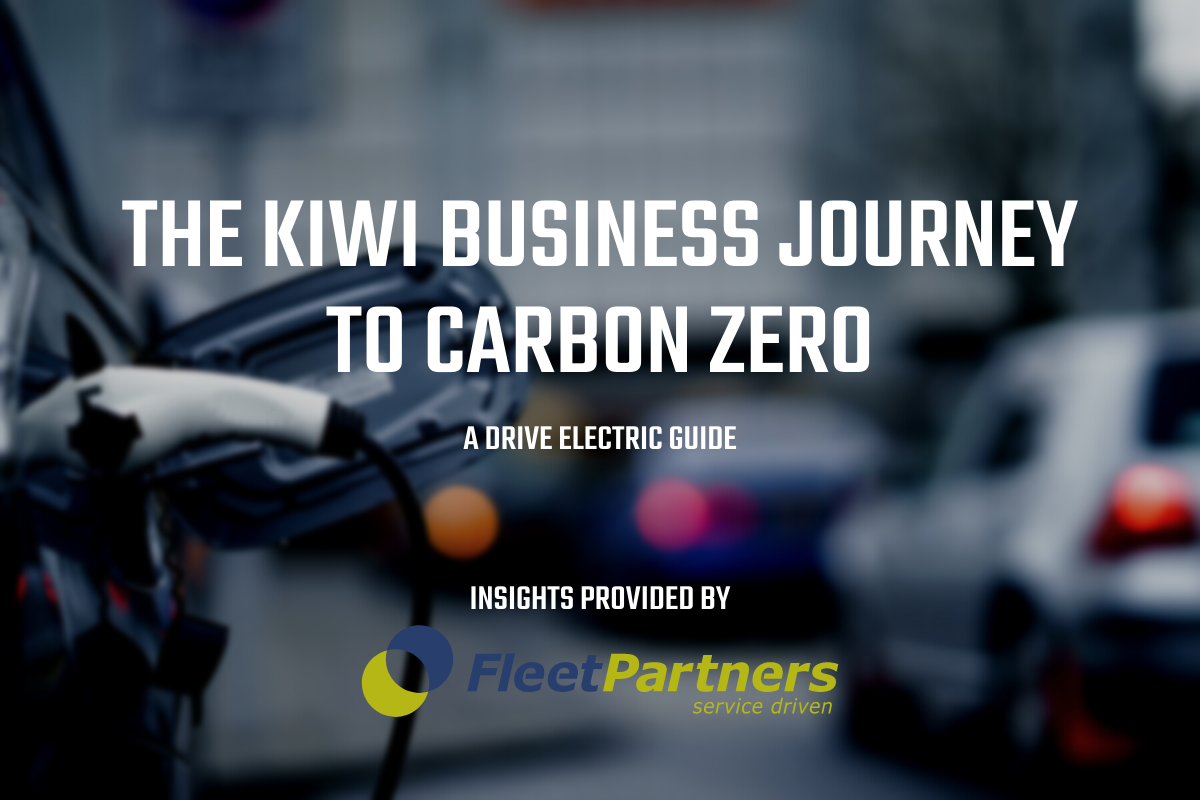FleetPartners is a Premium member of Drive Electric. They are a leading vehicle leasing and mobility solutions company with over 3,000 customers and over 25,000 vehicles on the road. By combining flexibility and experience with industry-leading technology, Fleet Partners offers innovative, cost-effective, tailored solutions designed to meet the needs of every business.
This 5-step guide contains insights from FleetPartners for fleet managers and business owners looking to transition from internal combustion engine vehicles to hybrid and electric alternatives, whether you have 1, 20 or 500 vehicles.
GET ON THE JOURNEY TO CARBON ZERO
Lower your company-wide emissions with sustainable vehicles
Businesses big and small will play a vital role in reducing New Zealand’s carbon emissions through the transition to more sustainable transport.
Many studies show that battery electric vehicles (BEV) produce approximately 80% less CO2 emissions over their lifetime (including manufacturing and recycling) compared to an internal combustion engine vehicle (ICEV). This advantage in emissions reduction will only improve as New Zealand meets its policy targets for the reduction of the carbon intensity of electricity production.
Not only is there a positive impact on the environment, but there is a strong business case for switching to hybrid electric vehicles (HEV), Plug-in hybrids (PHEV) and BEVs with potentially lower fleet operating costs and an enhanced reputation for the business as it becomes more sustainable.
Businesses in NZ are setting new targets for their fleets to reduce CO2 emissions and driving down fleet costs. Transitioning to a lower carbon fleet is becoming more appealing to Boards, Executive teams, entrepreneurial startups and fleet managers, as EV and plug-in hybrid make and model availability grows and charging infrastructure reach increases.
With the advancement of technology in hybrid and electric vehicles, and an increase in vehicle supply, FleetPartners customers are increasingly reaching out for help to reduce their carbon footprint through their vehicle fleet.
This requires more than a simple ‘replace ICE with EV’ approach. It requires a carbon strategy, an understanding of the fleet’s purpose, selecting the right vehicles for the job, getting vehicle charging correct, and bringing your team on the journey.
Step 1: Your carbon strategy

The first step is to look at what your business is trying to achieve in terms of emissions reduction and over what timeframe.
There may be external influences such as a directive from your Board or Executive team with emission reduction targets already set. You may run a small business and have an environmental conscience and want to be actively sustainable, or your competitors might already be operating sustainably.
Whatever the reason, it’s important to define your overarching goals and main drivers.
Some things to consider
What are the current CO2 emissions of your existing fleet?
You can calculate the number of tonnes that your vehicle emits per year and there are a couple of ways to do this.
- Find the CO2 emissions by inputting your vehicle registration number into rightcar.govt.nz or select the relevant make and model. You can then find the manufacturers claimed fuel consumption figures as well as CO2 output in grams per kilometre.
- If you have fuel cards and associated reporting, then you can find your actual fuel usage per kilometre and get a more accurate CO2 output based on actual fuel consumption and kilometres travelled.
By what percentage do you want to reduce your emissions and within what timeframe?
- Telematics data will give you the starting point of your existing emissions status. If you don’t have that, then you will need to analyse the distances and trips your vehicles are taking.
- If you want to gradually reduce emissions while keeping maximum pressure on fleet costs, you might be able to de-fleet (reduce the number of vehicles in your fleet) or swap your highest emitting vehicles with more fuel efficient (and economic) alternatives, such as plug-in hybrid vehicles.
- If you want to dramatically cut emissions, the best option may be to move your fleet to battery electric vehicles (BEVs). BEVs currently have a more expensive purchase price than internal combustion engine equivalents. You therefore will need to understand the cost implications of aggressive emission reduction. You could also look to transition your fleet to a pool vehicle fleet and reduce the number of personally assigned work vehicles.
You might switch employees to use their own vehicles for work purposes (this is a ‘grey fleet’).
If so, then consideration needs to be given to your company’s obligation under the Health and Safety at Work Act. If private vehicles are being used for business purposes, they need to be safe and compliant. This option may not achieve sustainability benefits and emissions reduction.
To clearly outline the costs versus the benefits of the different options, put together a business case.
In doing this, engage your employees and stakeholders and consider their needs and wants. You need to get them involved early in the process. You might want to start by doing a small trial first in one location. This can help you evaluate the benefits and issues associated with the adoption of low emissions vehicles.
You should develop a fleet strategy that matches your overall carbon strategy. Creating a business case and analysing different options and different mixes of vehicles is highly recommended. This will determine where you want to land in terms of your goals for cost reduction and emissions targets.
Business example
A NZ finance institution approached Fleetpartners to create a carbon strategy to reduce their fleet’s carbon footprint. They reviewed their current fleet policy and selected lower CO2 emissions vehicles.
They rewrote their company’s vehicle policy, focusing on ‘job required’ vehicle allocations and defined a minimum threshold of 15,000kms per year for business use. They then started to cash up those drivers in company allocated cars that did not meet their threshold.
They installed telematics devices to monitor kilometres travelled as ‘business use’ as well as driver behaviour. The installation of a pool booking system was completed and pooled fleets were adopted in main city centres to provide mobility solutions to those staff needing a vehicle to get around.
Step 2: Your Fleet Mission

Understanding the fundamental purpose of your fleet and how it is being used is the next step.
Every fleet manager or business owner will want to achieve full utilisation of their vehicles, however this is not always possible. Business vehicles need to be fit for purpose for the job that needs to be done.
Some things to consider
What roles do your vehicles play in your business and what do they need to do?
- Do you need them to transport staff to and from home and work, or from one company location to another?
- Do your team need to visit customers across cities and deliver products locally or regionally?
How do you achieve the outcomes you need and your emissions goals most efficiently?
You can assess the best mix of mobility solutions and consider:
- If your business needs personally assigned vehicles
- If a pool vehicle fleet would work better in certain locations
- If your staff are using taxis, Ubers and subsidised public transport to get around and what impact that has on cost and emissions.
The best way to analyse your fleet and how its travelling is through telematics (GPS) data.
This allows you to understand:
- How your drivers are driving to and from locations of work
- How they are planning their routes
- What mix of pool fleet versus permanently allocated company vehicles you may want
- How to review your existing vehicle policy and the impact of remote working on your fleet utilisation.
- If you don’t have GPS tracking data, then you can estimate daily range requirements based on odometer readings or fuel card data.
You should look at vehicle inclusions within employment contracts.
This might help you understand what policy changes can be accommodated and that these changes don’t overwrite existing contract clauses.
Once there is the understanding of current state, you can design a future state that supports your carbon strategy, within the timeframes you have set.
This involves determining which vehicles can be transitioned to zero-emission now; pool fleets are generally good candidates for zero emission vehicles.
What about vehicles that are not suitable to move to low emission (yet!)?
Within the next few years, we hope to see more electrified commercial transport options. In the meantime, businesses could choose to offset the emissions and then sign-write their vehicle with something like, “I can’t be an EV, so we’ve planted a tree”. Your fleet transformation plan might also include options like greater use of Uber or public transport.
Step 3: Vehicle selection

The selection of your vehicles is an important step to ensure that they work for the purpose that they are intended. There are several things to consider when selecting more sustainable vehicles for your fleet.
Some things to consider
What choice of low or zero carbon vehicles are out there in the market now?
Find out what’s available and what their carbon emission profile is.
Analysis of your existing fleet movements
Analysis will allow you to select vehicles with appropriate performance (in particular, kilometre range) to meet your needs.
Consider the whole of life costs for the vehicles you are interested in.
EVs have higher capital cost and lower operating costs than ICE and hybrid vehicles. Your fleet analysis will let you determine the relative costs of various hybrid and EV options.
Do your vehicles need additional fitouts to ensure they can perform the task intended?
Perhaps with accessories, fitouts, or special features, they will be more fit for purpose?
What image do you want to portray to staff and to customers?
How will that impact your choice of make and model? Will your vehicles be signwritten?
Consider the make and models of vehicles that might keep staff more engaged.
Consideration should be made on health and safety features, as well as how the vehicle will fit in with their lifestyle. If it’s not the right fit, staff may not want to use the vehicle.
Consider the maintenance required for charging particular vehicles, and their battery power.
Business example
A FleetPartners customer had a company car policy of large 6 cylinder utes and SUVs for their rural and commercial teams. These vehicles emitted around 230g/kms and 210g/kms of CO2 emissions respectively. In order to meet their emissions targets, they looked at the use of their vehicles and decided to move these to smaller “all wheel drive” hybrid options, with CO2 emissions ranging from 115g/kms to 165g/kms. This gave them the power they needed for rugged terrain without the excessive fuel bill. For their pool fleet, a full battery electric vehicle option with zero emissions was chosen as an ideal option for the relatively short journeys covered on a day-to-day basis.
Step 4: Charging and infrastructure

Charging keeps your vehicles moving and your drivers on the road.
The cost to install chargers at your workplace can vary hugely depending on the type of charger and the characteristics of the site. If you want your staff to charge at home, there are some additional complexities to consider. You will need to be guided by your fleet mission or purpose.
Some things to consider
When, where and for how long are your vehicles available to be charged?
That is, can you charge vehicles at your workplace slowly overnight, or do you need fast charging during the day?
How much electrical supply capacity is there at your workplace?
- When are your peak demand periods that might constrain charging during these times?
- Will you need to upgrade your power supply?
Who will pay for the EV chargers and any site upgrades that are required?
How do you navigate landlord vs tenant responsibilities and costs?
If you allow staff to take vehicles home, do you pay for the installation of a home charger?
What happens if the employee shifts house or leaves the company? How does your employee claim the cost of electricity used to charge his or her work vehicle? What are the health and safety considerations of home charging of work vehicles?
Are the charging and infrastructure investments impacted by other aspects of your carbon reduction strategy?
For example, if you install solar panels on your office roof or make energy efficiency improvements at your facilities, then you might not need to upgrade your main electricity supply.
Do you want your electric vehicles charged only by renewable energy?
Do you need to find an electricity retailer with a zero-carbon product?
How do I get the right charging infrastructure right now?
And how do I allow for further transition of our fleet in the future?
You will need to gain a good understanding of your charging requirements. Whether you need one charger or 100 chargers, procure a solution that’s fit for purpose and future proofed. There are options (such as leasing chargers alongside vehicle leases) that can reduce your up-front costs.
Learn more about charging infrastructure here:
Business example
Northland District Health Board required an assessment of electricity demand and capacity to determine what supply upgrades were required for their electric vehicles across their site locations. FleetPartners engaged with electrical consultancy experts Wedgewood White to conduct a fact-finding workshop, followed by a comprehensive assessment of electricity demand and capacity, including peak usage times. The charging solution designed was focused on ensuring scalability of their fleet and enabling smart charging overnight for their pool fleet which didn’t affect their electricity supply during peak times during the day.
Step 5: Vehicle policy and employee engagement

Introducing plug-in hybrid vehicles into your fleet is generally relatively straightforward. However, pure electric vehicles can be met with reluctance by some staff, due to their perceived limitations of range and features.
So, how do you get your staff on board and excited about moving to more sustainable vehicles? It’s imperative to get strong uptake from the outset; education and test driving is important. A good vehicle policy and overcoming common misconceptions about EVs requires some planning.
Some things to consider
Get your team test driving different styles of hybrid and electric vehicles early on.
Doing a driving day can educate staff on the benefits for the environment, transform their perception of vehicle limitations and overcome range anxiety.
Provide information on the types of vehicles including technology, features and benefits.
It can take people time to understand the benefits, so test driving is critical. Often, as soon as someone drives an EV, they’ll be happy to go electric full time!
If you decide on plug-in hybrids, how do you encourage the use of chargers to extract the full environmental and commercial benefits?
This is particularly when it’s optional to charge the vehicle versus using fuel.
Transitioning your tool of trade vehicles to EVs will require more staff engagement.
You may need to do a review of various vehicle policies and a clear plan for charging arrangements.
Get a solid change management process in place to plan ahead.
This will decrease costs and improve your team’s satisfaction. Listen to employee concerns and address them effectively.
How do you decide which vehicles should be allocated to drivers?
You need to look at what suits their role and the vehicle’s purpose.
Education around NZ’s national charging network and availability of charging across the country is important.
There are nationally accessible networks through suppliers like ChargeNet, and these suppliers can charge back through your lease company to track costs.
Decide who pays for home charging or what happens if an employee can’t charge at home.
Consider how employees feel about the image they have of a certain vehicle.
This includes how it fits with their lifestyle (if it’s not a pool vehicle) when they are using the vehicle and not at work.
Take the lead. Electrify your business.
Electric vehicles have become the practical, sustainable choice for business in New Zealand. By transitioning your fleet to electric, you can:
- Position your company as a national leader in climate action and tech
- Exercise your corporate responsibility
- Benefit your bottom line
- Offer your staff an enhanced, safer driving experience.
Read more from Drive Electric about the business case for switching to electric vehicles here.
There are many aspects to transitioning a vehicle fleet to low or zero carbon status; there is certainly a lot to consider and manage! Getting your overarching carbon strategy in place is key. From there, a successful transition to EVs requires a sound understanding of the purpose and utilisation of the fleet, selecting the right vehicles for the job, implementing the most suitable charging solution and getting employees on board with the change.
If you are wanting to learn more or begin the electric journey for your business, get in touch with the FleetPartners team.
Drive Electric membership
Many of the companies among our Drive Electric membership are at the forefront of the shift towards an electric transport future. As an organisation, we offer hands-on support and expert advice, and connect you with Kiwi companies who have the insight you need to make e-mobility a success for your business. Learn about the many benefits of our future-focused community here.






